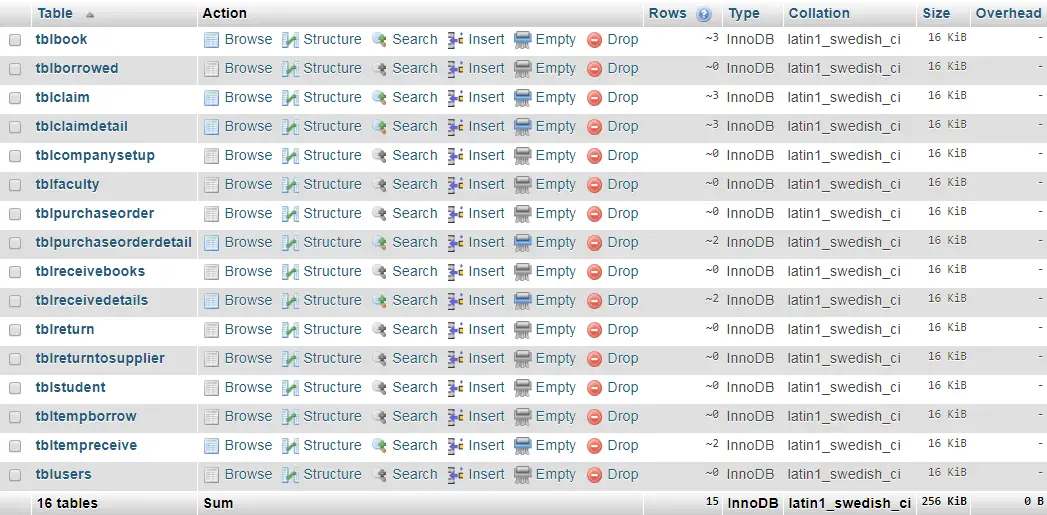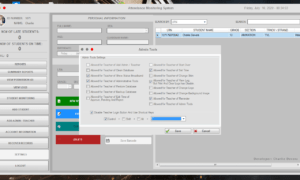Generative CRM System Using Hashbrown
Table of Contents
- Generative CRM System Using Hashbrown
- Introduction
- What is Hashbrown?
- Project Overview: Generative CRM System
- Objectives of the Project
- Technology Stack
- Features of the System
- 1. Dynamic Customer Dashboard
- 2. Lead Management and Scoring
- 3. Automated Communication
- 4. Predictive Analytics and Reports
- 5. Generative UI for Workflow Customization
- 6. Role-Based Access Control
- 7. Customer Feedback Analysis
- 8. Integration with Existing Tools
- Workflow Overview
- Benefits of Using Hashbrown for CRM Development
- Practical Applications Across Industries
- Summary and Conclusion
Introduction
In today’s fast-paced business world, Customer Relationship Management (CRM) systems play a vital role in building meaningful connections with customers and driving sustainable growth. However, traditional CRM solutions often require extensive manual setup and customization, which can be time-consuming and resource-intensive.
This is where Hashbrown, a Generative UI and automation platform, comes in. By leveraging Hashbrown’s AI-powered interface generation, developers and businesses can rapidly design, deploy, and manage intelligent CRM systems with minimal coding effort.
This blog explores how to build a Generative CRM System using Hashbrown, the technologies involved, its features, and its potential to revolutionize how organizations manage customer relationships.
What is Hashbrown?
Hashbrown is a Generative User Interface (Generative UI) platform that uses AI to automatically design and generate front-end interfaces based on data models and workflows. Unlike traditional development tools, Hashbrown minimizes manual UI creation by generating adaptive, responsive layouts powered by artificial intelligence.
Purpose and Use Case:
The main purpose of Hashbrown is to accelerate digital transformation by enabling developers, educators, and enterprises to create functional and intelligent systems—like CRMs, dashboards, and automation tools—without extensive coding.
Advantages:
- Rapid UI Prototyping: Instantly generates dynamic interfaces from data models.
- AI-Driven Adaptability: Automatically adjusts UI components based on user input or workflow changes.
- Integration-Ready: Connects easily with APIs, databases, and backend systems.
- Cross-Industry Flexibility: Applicable in education, healthcare, logistics, business intelligence, and customer service.
Project Overview: Generative CRM System
A Generative CRM System using Hashbrown combines artificial intelligence, data-driven design, and automation to enhance customer engagement and streamline operations. Instead of building static CRM interfaces, developers can use Hashbrown to generate intelligent modules—such as dashboards, client interaction logs, and lead management panels—on demand.
This project integrates AI to personalize customer journeys, analyze sales trends, and automate client communications, offering a smart and adaptive CRM solution for modern businesses.
Objectives of the Project
The main objectives of the Generative CRM System are to:
- Automate UI Generation: Utilize Hashbrown to dynamically create CRM interfaces such as customer dashboards, contact lists, and analytics pages.
- Enhance Decision-Making: Implement AI models for predictive sales analysis and customer behavior forecasting.
- Improve Customer Engagement: Streamline communication channels through email, chat, or SMS automation.
- Reduce Development Time: Replace manual coding with AI-assisted UI and workflow generation.
- Ensure Scalability and Customization: Build a CRM that adapts to changing organizational needs and client data.
Technology Stack
| Component | Technology Used | Purpose |
|---|---|---|
| Frontend | Hashbrown Generative UI, HTML5, CSS3, JavaScript | Automatically generate adaptive and responsive UI components |
| Backend | Node.js / Python (Flask or FastAPI) | API management and business logic |
| Database | MySQL / PostgreSQL | Store customer, sales, and transaction data |
| AI Integration | OpenAI API / TensorFlow | Predictive analytics, sentiment analysis, and lead scoring |
| Authentication | JWT / OAuth 2.0 | Secure user login and data access |
| Deployment | Docker / AWS / Vercel | Hosting, scaling, and CI/CD automation |
| API Integrations | Email APIs, Twilio, CRM Webhooks | Communication and automation features |
Features of the System
1. Dynamic Customer Dashboard
The system generates AI-driven dashboards where users can view real-time customer insights such as demographics, purchase history, and recent interactions. Hashbrown’s generative engine ensures the layout adjusts dynamically based on data size and type.
2. Lead Management and Scoring
Using AI models, the system automatically scores leads based on historical data, engagement frequency, and customer behavior patterns—helping sales teams focus on high-value prospects.
3. Automated Communication
Integrate messaging APIs (email, SMS, chat) to automate follow-ups, reminders, and campaign notifications. Hashbrown’s modular UI allows quick customization of communication workflows.
4. Predictive Analytics and Reports
By integrating OpenAI or TensorFlow models, the CRM can forecast sales trends, identify churn risks, and provide recommendations for retention strategies.
5. Generative UI for Workflow Customization
Users can modify CRM workflows visually using Hashbrown’s no-code interface. The platform dynamically adjusts forms, buttons, and dashboards based on workflow changes.
6. Role-Based Access Control
Implement user roles (Admin, Manager, Staff) with customizable permissions. This ensures data security and prevents unauthorized access.
7. Customer Feedback Analysis
Integrate natural language processing (NLP) models to analyze customer feedback and sentiment from messages, reviews, or surveys.
8. Integration with Existing Tools
Easily connect with external services like Google Workspace, Trello, or Slack for seamless CRM operations and task tracking.
Workflow Overview
- Data Input: Customer and lead data are uploaded via CSV or synced via APIs.
- AI Processing: The system performs data enrichment and generates insights.
- Generative UI Rendering: Hashbrown auto-generates CRM pages, forms, and analytics dashboards.
- User Interaction: Sales teams use dashboards to manage leads and automate communications.
- Continuous Learning: AI models learn from new customer interactions and improve predictions.
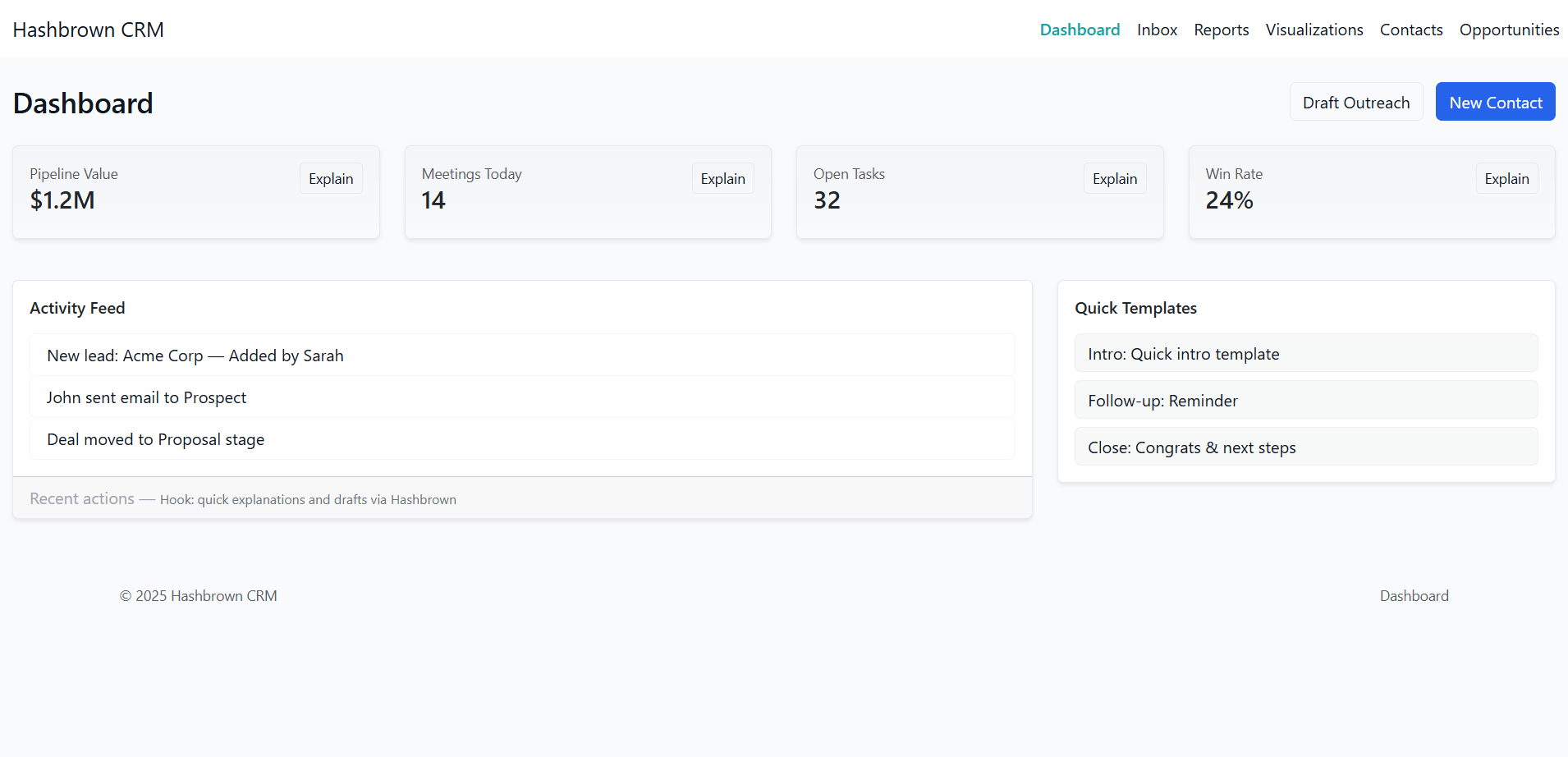
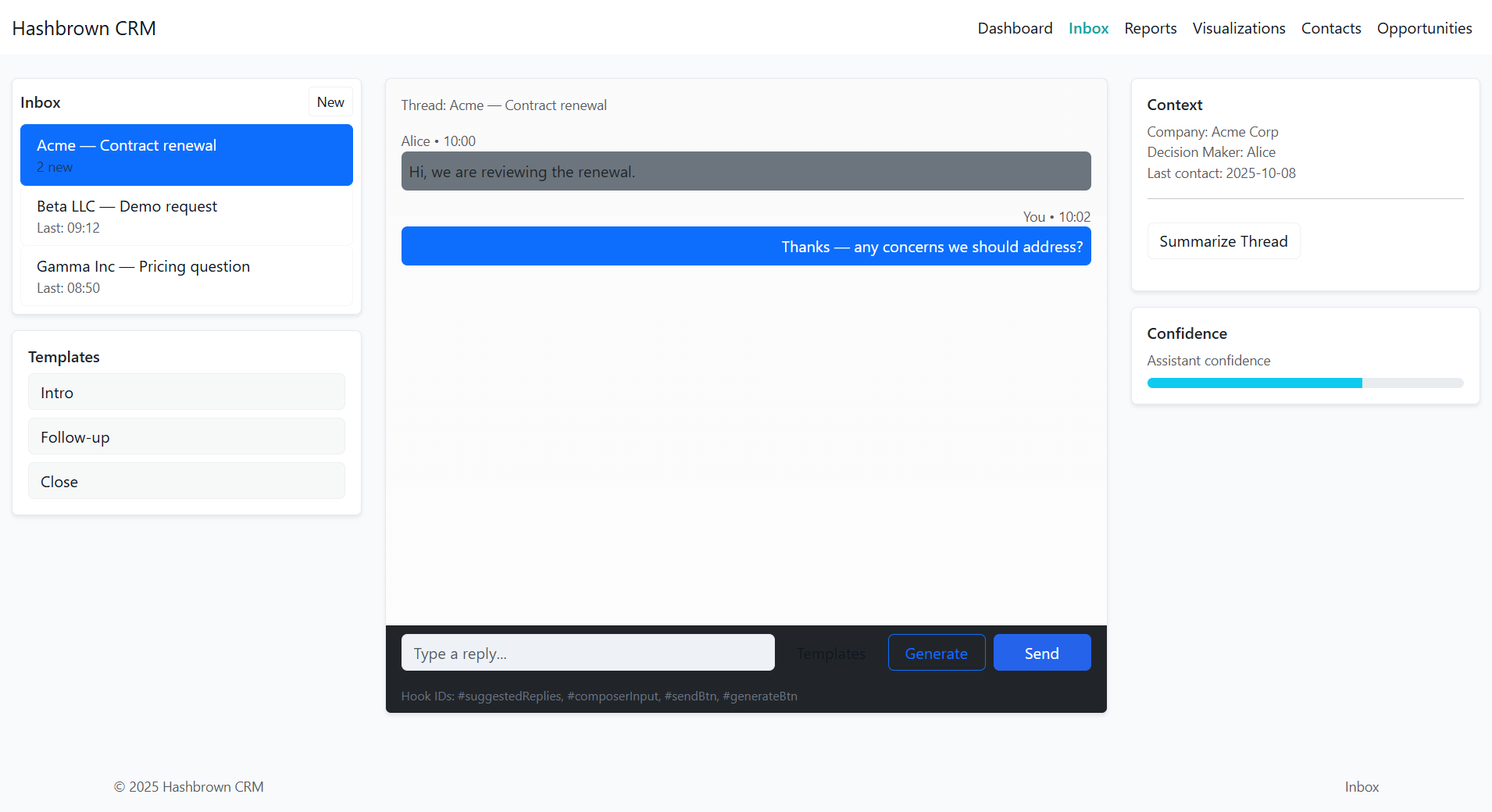
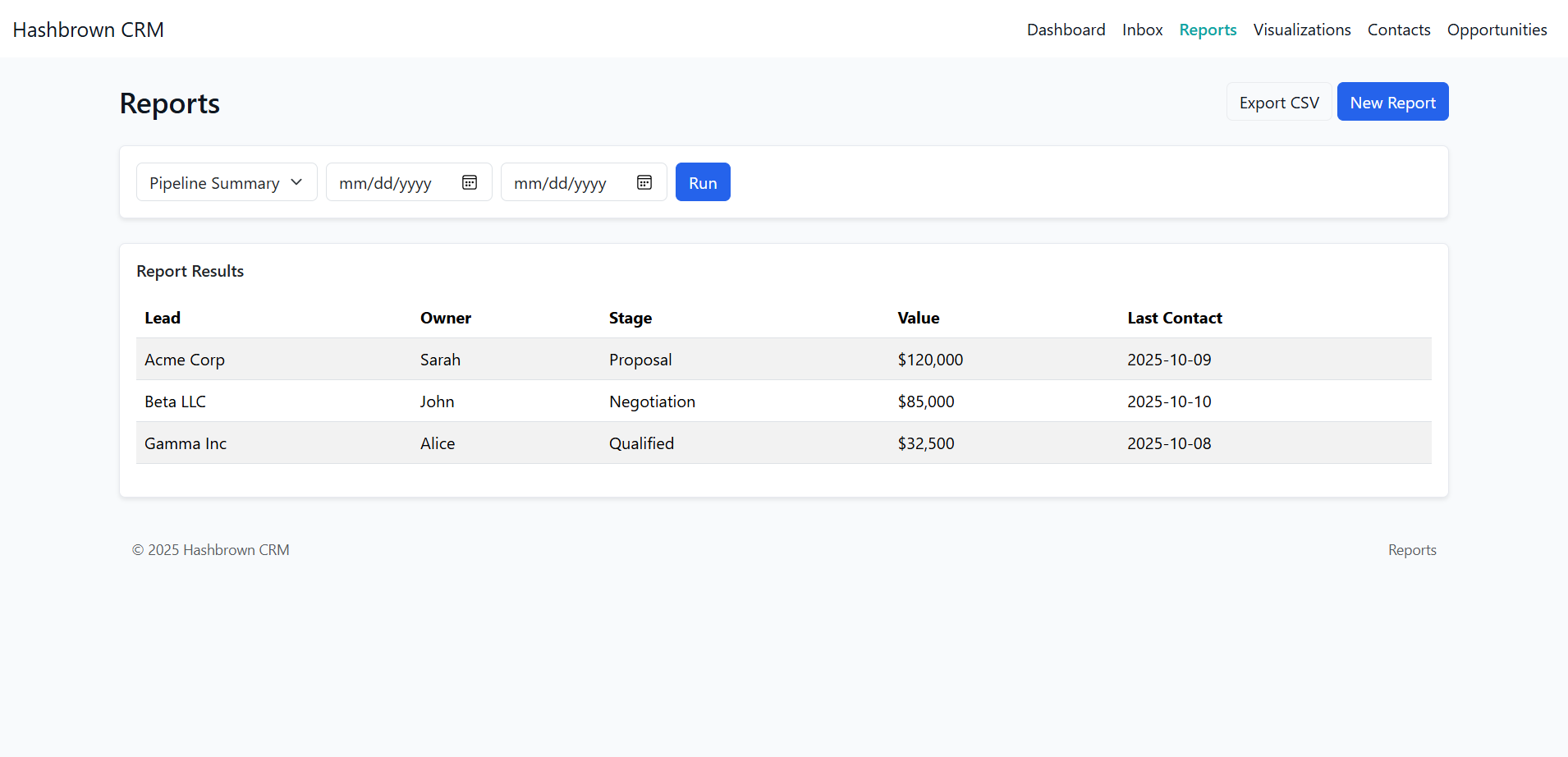
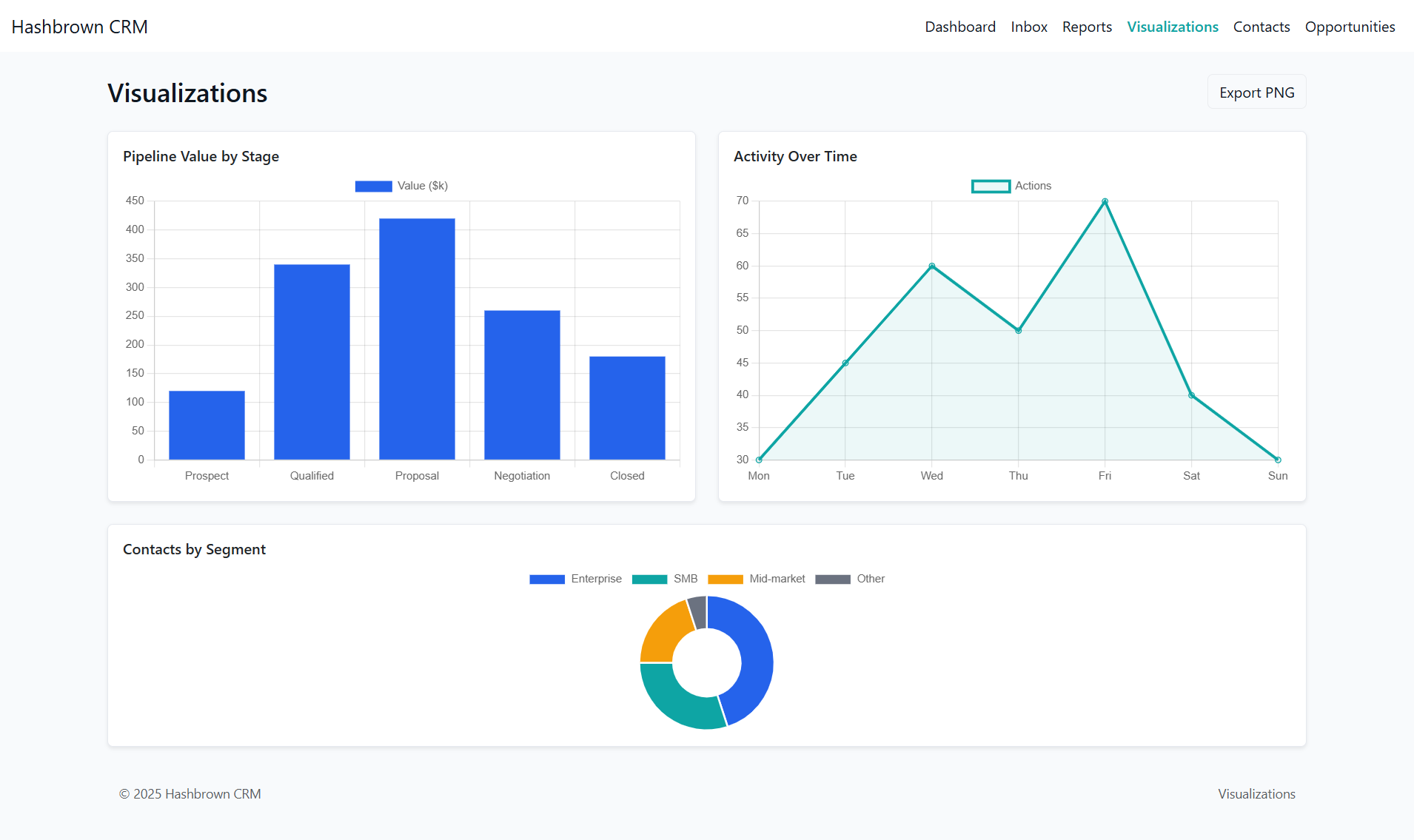
Benefits of Using Hashbrown for CRM Development
- Reduced Development Time: Instead of manually coding interfaces, teams can generate and deploy them within hours.
- Customizable at Scale: The CRM adjusts automatically to organization-specific workflows.
- Improved Productivity: AI automation reduces manual data entry and follow-up tasks.
- Scalable Architecture: Easily integrates with microservices and APIs for growing enterprises.
- AI-Powered Intelligence: Offers predictive insights and dynamic UI experiences based on user data.
Practical Applications Across Industries
- Sales and Marketing: Track lead conversions, campaign effectiveness, and customer feedback.
- Customer Support: Manage support tickets and automate FAQs through chatbots.
- Education: Manage student or alumni engagement and feedback loops.
- Healthcare: Track patient interactions and communication between doctors and clients.
- Real Estate: Manage property leads, transactions, and client communication.
Summary and Conclusion
The Generative CRM System using Hashbrown redefines how businesses approach customer relationship management. By leveraging Generative UI, AI-driven analytics, and automation workflows, organizations can rapidly create adaptive, intelligent, and user-friendly CRM systems.
Hashbrown’s ability to generate functional interfaces dynamically not only accelerates development but also enhances system usability, personalization, and scalability. As enterprises continue to adopt AI-driven tools, the fusion of Generative UI and CRM will play a crucial role in shaping the future of digital business management—empowering teams to focus less on code and more on meaningful customer connections.
You may visit our Facebook page for more information, inquiries, and comments. Please subscribe also to our YouTube Channel to receive free capstone projects resources and computer programming tutorials.
Hire our team to do the project.

